IDD and its implications to treatment
The discogram shows the effects of IDD (internal disc disruption) and clearly demonstrates why a desiccated and internally degraded nucleus will NOT give “normal/typical” migration-bending effects e.g. flexion & extension findings are ‘inconsistent’.
Since IDD is very common and it’s adverse effects on the hydraulic nature of the disc create a higher potential for annular tears (intolerance to torque) its important to understand its implications to treatment.
Though by no stretch entirely age-dependent it is more likely later in the 4th & 5th decades and suggests why repetitive extensions (facilitated movements) can be counterproductive and prone/prone extended decompression less of an imperative.
In younger populations it can be ‘assumed’ to be present when only one lumber disc is very ‘thin’ but the remainder appear normal. If its L4/5 (less common) typically we still try prone. If L5/S1 we more often go supine.


Leave a Reply
Want to join the discussion?Feel free to contribute!